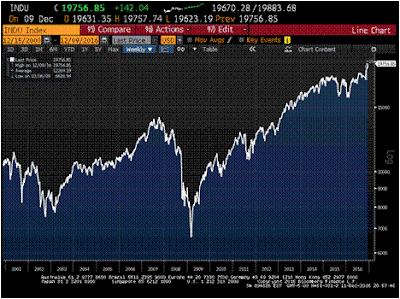We are approaching what appears to be a minor inflection point in the US stock market. The shortest price cycle – the Micro Market Resilience Index – is approaching a historically high level for the DJIA.
That said, my work indicates it is too soon call the end of this bull market for large US stocks. The conventional wisdom is that this bull market started in early 2009 and that it is already one of the oldest since WWII ( http://fortune.com/2017/03/09/stock-market-bull-market-longest/). The 8+ years of upward price movement places it as the second longest in the post war period.
However, my work indicates that the 2009 bull market ended in late 2014 to early 2015 (https://marketresilience.blogspot.com/2016/08/week-of-8222016-market-resilience-index.html). There was a clear bear market in terms of various resilience measures in 2015/16 but prices didn’t decline in the absence of resilience. I suspect that very low interest rates and a global effort to combat deflation were enough “good news” to prevent stock market prices from finding equilibrium at a level more consistent with their resilience levels.
Instead, the market trough was muted and the Phantom Bear Market of 2015/16 came and went and no one noticed.
Thus, the current bull market began in roughly March/April of 2016. The long term trend (Macro MRI) began moving higher at that time, well before the US presidential election in November 2016. The current bull market is therefore just over a year old. Market behavior (as measured by the various MRI) over the last year fits the image of a new bull market: very strong resilience in the first approximately twelve months, with moderate strength continuing for another few quarters.
I do not expect large price declines as we come upon the inevitable end of the positive short-term trend (of the Micro MRI). At this time, it does not appear that the declines will be like those of 2008, which dramatically marked the end of a bull market.
---
Our publications use price-based algorithms to determine the "resilience" of major markets, and our model portfolios are designed to rotate among markets by favoring the resilient markets and avoiding the vulnerable. Resilience describes a market's mood and relates to general investor enthusiasm. Resilience is seen in a market's ability to recover quickly from negative news and events. Changes in resilience over time are rhythmic and we seek to identify inflection points; these are appropriate times for shifting assets among markets.
Our publications use price-based algorithms to determine the "resilience" of major markets, and our model portfolios are designed to rotate among markets by favoring the resilient markets and avoiding the vulnerable. Resilience describes a market's mood and relates to general investor enthusiasm. Resilience is seen in a market's ability to recover quickly from negative news and events. Changes in resilience over time are rhythmic and we seek to identify inflection points; these are appropriate times for shifting assets among markets.

















